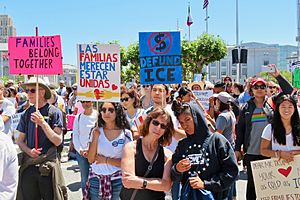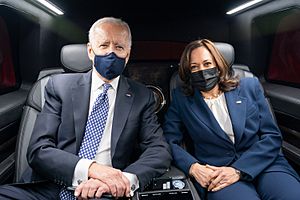Mexico–United States border crisis facts for kids

Border between Nogales, Arizona and Nogales, Sonora
|
|
| Motive | Illegal immigration to and asylum seeking in the US |
|---|---|
| Target | Migrants from Central America |
| Deaths | 7,216 (1998–2017) At least 853 in 2022 |
| Arrests | 2.3 million in 2022 |
The Mexico–United States border crisis is an ongoing migrant crisis in North America concerning the migration of undocumented immigrants from Latin America through Mexico and into the United States.
Mexican immigration to the US dates back to the end of the Mexican-American War. Migrant encounters at the Mexico–U.S. border began to surge in late 2020, reaching a record number of 1.73 million migrant encounters in fiscal year 2021, 2.76 million in fiscal 2022, and more than 2.8 million in fiscal 2023. The migrants, who are mostly of Guatemalan, El Salvadorian, Honduran, Nicaraguan, and Venezuelan citizenship, are reported to be escaping economic hardship, gang violence and environmental disaster in their home countries (particularly acute in Guatemala and Honduras) to seek asylum in the US.
The number of migrant encounters reached a peak in December 2022, when Border Patrol reported over 220,000 apprehensions.
Contents
Timeline
Obama administration
In 2014, the US declared a crisis at the border due to an influx of unaccompanied minors and women making their way through checkpoints. The US southern border had long struggled with implementing policies that aim to prevent immigration-related tragedies. With a decline in unlawful immigration from Mexico, the crisis predominantly concerned increased immigration from the Northern Triangle of Central America (NTCA), encompassing Honduras, Guatemala, and El Salvador.
In several places, dangers including kidnapping threatened thousands of Central American migrants who had been clustered in Mexican border cities like Matamoros, Tamaulipas, for months, blocked from seeking asylum in the US because of new restriction policies. The US government and United Nations provided free transportation to return refugees to their homes in Central America, but many others who were stuck in Matamoros said that desperation had led them to consider treacherous and potentially life-threatening methods of illegal entry—crossing the river, climbing into tractor-trailers driven by human smugglers, or both. In 2019, as the USBP reported, the number of migrants caught hiding in tractor-trailers along the border had risen by 40 percent that year.
Trump administration

In September 2019, the US Supreme Court allowed a new ruling to take effect that could curtail most asylum applications at the border. The ruling would demand that most asylum seekers who pass through another country first will be ineligible for asylum at the US's southern border. Mark A. Morgan, acting commissioner of the US Customs and Border Protection (CBP), stated the ruling was set to take effect on the week of October 8, 2019. In an interview with Time, Donald Trump criticized the Obama administration for the separations immigration policy. As the Trump administration stated, the policy is necessary to decrease the "fraudulent" asylum claims among the entrance of Central American families coming to the border.
The Trump administration tried to stop migrants from getting into the US at all, asking them to take a number at the border and to wait until they are called for a chance to have their asylum cases heard. As a result, in September 2019, the US immigration court faced over one million waiting for their cases to be heard, matching the highest backlog seen in the US.
Biden administration

On January 13, just one week prior to Biden's inauguration, more than 3,000 people departed Honduras and El Salvador for the US. That number grew to approximately 7,000–8,000 one week later. On January 16, Guatemala and Mexico deployed the military to their borders, in an attempt to stop the migrant caravan from transiting through their countries on the way to the US to no avail.
On his first day in office, Biden halted the construction of Trump's Mexican border wall, ending the national emergency declared by the Trump administration in February 2019.
In March 2021, amid a rise in migrants entering the US from Mexico, Biden told migrants: "Don't come over." He said that the US was arranging a plan for migrants to "apply for asylum in place", without leaving their original locations. In the meantime, migrant adults "are being sent back", Biden said, in reference to the continuation of the Trump administration's Title 42 policy for quick deportations as migrants continued to cross into the US. Biden earlier announced that his administration would not deport unaccompanied migrant children; the rise in arrivals of such children exceeded the capacity of facilities meant to shelter them (before they were sent to sponsors), leading the Biden administration in March to direct the Federal Emergency Management Agency to help manage these children, but facilities are being overwhelmed because of the numbers of adults and children coming into the country.
On March 24, 2021, Biden tasked Vice President Kamala Harris to reduce the number of unaccompanied minors and adult asylum seekers. She is also tasked with leading the negotiations with Mexico, Honduras, Guatemala, and El Salvador. In June 2021, Vice President Harris visited Guatemala and Mexico in an attempt to address the root causes of migration from Central America to the United States. During her visit, in a joint press conference with Guatemalan President Alejandro Giammattei, Harris issued an appeal to potential migrants, stating "I want to be clear to folks in the region who are thinking about making that dangerous trek to the United States-Mexico border: Do not come. Do not come."
In September 2021, over 30,000 Haitian migrants crossed the border in the Del Rio, Texas, sector. At one point, a migrant camp beneath the Del Río–Ciudad Acuña International Bridge contained over 15,000 temporary residents. The squalid conditions in the camp attracted widespread international attention. Photos of horse-mounted USBP agents allegedly mistreating migrants led to an incident conservative media referred to as Whip Gate.
The USBP detained more than 1.7 million migrants crossing the Mexico–US border illegally in the 2021 fiscal year, the highest number ever recorded. In November 2021, only 31 percent of Americans approved of the president's handling of immigration.
Proposed legislative remedies
Following months of negotiations, on February 4, 2024, a bipartisan group of senators released a 370-page bill intended to sharply reduce incentives for migrants to attempt border crossings. The bill included a "border emergency" provision that would automatically require the border to be closed if border encounters reached an average of 5,000 per day over several days; Trump, Speaker Mike Johnson and other Republicans falsely asserted the bill allowed 5,000 illegal border crossings per day. The bill would end the practice of "catch and release" that allows migrants entry into the country while they await immigration hearings; instead, migrants would be detained pending hearings. The bill also provided for a tighter asylum application and approval process, with speedy removal of migrants who do not qualify. The plan included hiring thousands more border patrol and asylum officers and increasing detention capacity. It also provided for thousands of work visas for migrant spouses of U.S. citizens awaiting immigrant visas. President Biden supported the bill, while Speaker Johnson said days before its release that it would be "dead on arrival" in the Republican-controlled House. Shortly after the proposal was announced, House majority leader Steve Scalise declared it would not be brought before the House for a vote. One negotiator, independent Arizona Senator Kyrsten Sinema, asserted the border would have been closed every day so far in 2024 if the bill had been law; Biden promised in January that he would immediately close the border if the bill was enacted. Lead Republican negotiator James Lankford of Oklahoma, among the most conservative Republican Senators, attempted to defend the bill throughout the weeks leading to the vote. Trump, the leading Republican candidate for president in 2024, publicly and privately pressured Republicans during the Senate negotiations to oppose the proposal. The National Border Patrol Council, a labor union representing some 18,000 border patrol officers, quickly endorsed the Senate bill. The union had endorsed Trump in the 2020 election and had been sharply critical of Biden's policies.
Senate Republicans swiftly turned against the bill upon its release, after Trump openly said he did not want Joe Biden to score a political win with the legislation. On February 7, Senate Republicans blocked the proposal in a floor vote. Lankford said on the floor before the vote that a "popular commentator" had told him a month earlier, "'If you try to move a bill that solves the border crisis during this presidential year, I will do whatever I can to destroy you, because I do not want you to solve this during the presidential election.'" Two days before the vote, Trump told a radio host, "This is a very bad bill for his career," while falsely denying he had endorsed Lankford in 2022. The $118 billion package included $60 billion for Ukraine military and $14 billion for Israel. Trump said at a rally days later, "We crushed crooked Joe Biden's disastrous open borders bill," while Biden said, "Every day between now and November, the American people are going to know that the only reason the border is not secure is Donald Trump and his MAGA Republican friends."
See also
- Mexico–United States border
- Replacement migration
- Remigration


